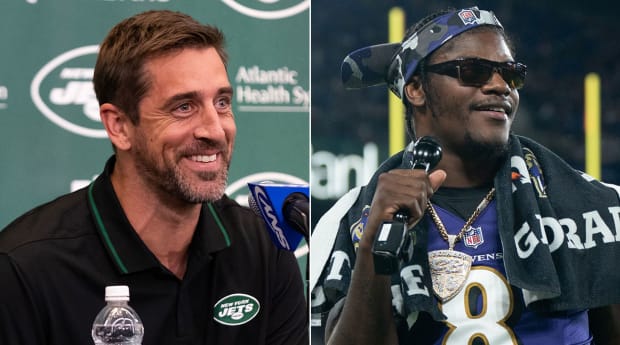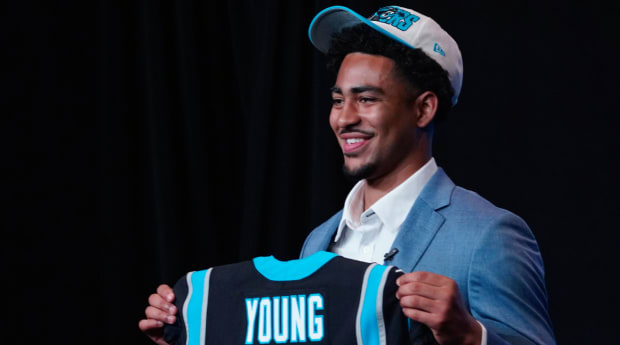While much of the focus during the 2023 draft was on incoming players, the business of the NFL also saw the resolution of the two biggest questions about veteran quarterbacks in the league. Perhaps the draft was a deadline for both deals. And—no surprise here—the party with the most leverage in each equation got the better of the other side. Let’s examine.

Tom Horak/USA TODAY Sports (Rodgers); Jessica Rapfogel/USA TODAY Sports (Jackson)
Aaron Rodgers and the Jets
This situation was finally resolved, six weeks removed from Rodgers saying his “intention was to play for the Jets.” The uncanny déjà vu from 15 years ago is now complete, as back then, when I worked for the Packers, we traded a Hall of Fame quarterback (then Brett Favre, now Rodgers) to the Jets to pave the way for a first-round quarterback (then Rodgers, now Jordan Love) who had been apprenticing for three years. Get ready, the 2038 trade of Love to the Jets will be fascinating.
As I wrote here and said consistently, the Packers had the leverage here; and I thought they used it well.
Leverage belongs to the party in the negotiation that is most comfortable with the status quo. The status quo for the Packers was (1) they had their quarterback on the roster (Love); (2) they owed Rodgers no money until September; and (3) Rodgers was not around the building to cause a distraction or disruption (to those who think he would have shown up, please).
The status quo for the Jets was (1) they had no quarterback (Rodgers was Plan A, B and C); (2) they openly lusted after Rodgers after flying a contingent to his house to beg him to play there; and (3) their fan base was frothing at the mouth for the trade.
With those status quos, the Packers extracted:
• A move from the 15th to the 13th pick in the 2023 draft
• A high-second-round pick in the 2023 draft
• A second-round pick in 2024 that converts to a first-round pick simply with 65% playtime, without any statistical or playoff contingencies
• The removal of a $60 million financial obligation for this year and potentially a $100 million financial obligation over two years.
All for a player who was never, ever going to play for them again! The Packers did well here.
To make one final point here: There were times when, working for the Packers, I felt like we were at a disadvantage in not having an owner, especially where I noticed league officials treating teams with owners better than I thought they were treating us. Overall, though, I was thankful not to have an owner. I had incredible autonomy to run our player payroll in Green Bay. The lack of owner proved an advantage in this transaction.
I believe they won this trade in part because Jets owner Woody Johnson finally said: Get it done! The Jets could feign aggressive negotiating only so much; in the end they gave up much more, I think, than they were offering six weeks ago.
The Packers were well served not having an owner.
Watch the NFL with fuboTV. Start your free trial today.
Lamar Jackson and the Ravens
This two-year saga that featured no traditional agent, a trade request and a franchise tag that was never signed has finally found resolution.
The contract has a reported $260 million in overall value, though it is not clear how much of the reported $185 million guaranteed is “full”—guaranteed at signing—rather than injury guarantees that eventually convert to true guarantees (much less valuable to the player). My sense is the deal is probably for three years for $135 million, which “should” trigger another $50 million in future guarantees, but as we know with NFL contracts, who knows?
The contract appears to be a trade-off similar to the recent deal between Jalen Hurts and the Eagles: The player “wins” the average per year (Jackson set a new record with $52 million per year); the team “wins” the guarantee issue, with only the low-risk early years of the contract secured.
Jackson’s deal is better than Hurts’s, though, as a true five-year deal, not Hurts’s six years (a five-year extension to his existing year). Hurts’s total value is $259 million over six years; Jackson’s is $260 million over five years. To be fair to Hurts, his “jumping-off point”—the amount that he was scheduled to make absent an extension—was $4 million; Jackson’s jumping-off point was the tag number of $32 million. Jackson “should” make $28 million more, at least, than Hurts.
The larger point is the one that has now become clear: The fully guaranteed Deshaun Watson contract appears to be an aberration. Both “agented” players who signed after Watson—Kyler Murray, Russell Wilson, Derek Carr, Daniel Jones, Hurts, etc.—as well as the “unagented” Jackson faced similar fate.
NFL owners—whether legally collusive or not—play hardball, and they came out swinging against the Watson deal, banishing it to outlier status. They used the leverage of undervalued rookie contracts (Murray, Hurts), older players looking for one more payday (Wilson) and the tag (Jackson) to forge team-friendly structures, no matter the amount of the contract. And my sense is the trend will continue this offseason with Joe Burrow and the Bengals and Justin Herbert and the Chargers.
Thus, NFL player contracts, when compared to MLB and NBA player contracts, continue to sit at the children’s table.
Rookies lose again

Jim Dedmon/USA TODAY Sports
There is much hoopla over the draft and the excitement over the incoming class; it is all good business for the NFL. And even better business for the NFL is how rookie contracts work since the past two collective bargaining agreements. The rookie wage scale now operates to (1) mandate all drafted players sign four-year contracts; (2) prohibit renegotiations of these contracts for at least three seasons; and (3) predetermine the financial compensation of every drafted rookie.
As to that predetermined compensation, the 2023 class is going to make virtually the same as the ’22 class, which made virtually the same as the ’21 class. As in ’22, ’23 rookie signing bonuses will rise only 1%. For example, this year’s top pick, quarterback Bryce Young, will have a signing bonus of $24.6 million, only 1% more than the $24.36 million received by last year’s top pick, defensive tackle Travon Walker.
Why so nominal an increase? This is continuing fallout from the 2021 COVID-19-related cap decline of 8%, when the NFL and the NFLPA made the decision not to change the rookie salary formula for that season. Rather, they decided to claw back increases for future draft classes, keeping the rookie bonus increases at only 1% while the overall cap increases were 14% in ’22 and 8% in ’23.
In every CBA, there are a multitude of issues negotiated, many of which are contentious. Not so, however, when it comes to the treatment of incoming players (rookies). Owners don’t care about what they make, and the veteran players negotiating the CBA often feel the same.
Rookies have no one lobbying for them other than, perhaps, agents, and no one cares what agents think. When in doubt, take it out on the rookies.
Rookie contracts are the CBA gift to NFL teams that keep on giving.
First round optionality
Speaking of team advantages on rookie pay and rookie contracts, Tuesday was the deadline for NFL teams to exercise fifth-year options on first-round picks from the 2020 draft. And the results are stark: Just 12 of the 32 players picked in that class were optioned. Only 14 were non-optioned on deadline day; five are no longer on the team that drafted them, and one signed a new contract to bridge the option (more below).
In the recent CBA, the NFLPA made some gains (I think) by requiring the option year to be fully guaranteed. In the past, it was only guaranteed for injury; teams had low risk in exercising the option. Now they have to think hard about putting a big number on the player a year out, even if it could come back to haunt them, as it did with the Giants and Daniel Jones (the non-exercise of a $20 million option cost the team $82 million over the next two years).
The Packers’ new quarterback, Love, was from that class, and the team wrestled with the decision before working out a two-year deal with him, covering 2023 and what would have been the option year, ’24. The Packers now guarantee Love $13.5 million over the next two years—instead of $2 million this year and an option (or not) of $20 million, with upside for Love up to $22.5 million. The Packers were willing to gamble $11.5 million to bet against a Daniel Jones situation, while Love protected his downside risk. Seems like a sensible deal for both sides.







